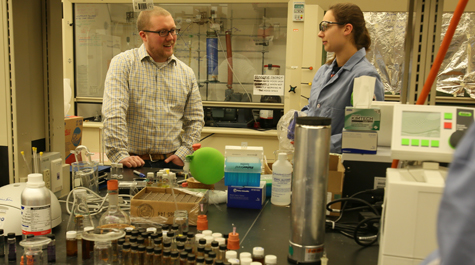Using a CAREER award to turn over a new energy leaf
To witness one of the most advanced solar-powered machines on Earth, look no further than your houseplant. That plant may hold the key to humanity’s future energy source, says William McNamara.
The energy generated by mimicking photosynthesis has the potential to one day power everything from our electric grid to rockets, says McNamara, an associate professor of chemistry at William & Mary.
McNamara was inspired by the way nature uses sunlight as an energy source, so he set his sights on developing a way to harness and store solar energy as a chemical fuel compatible with our current energy infrastructure. His “bio-inspired” approach starts with sunlight and ends with hydrogen gas.
He recently received a five-year CAREER award from the National Science Foundation to continue his research, which he is doing with a team of undergraduate W&M students. The NSF awards CAREER funding to “early-career faculty who have the potential to serve as academic role models in research and education and to lead advances in the mission of their department or organization.”
The development of clean and sustainable energy is one of the most pressing issues facing society today, McNamara said. The sun provides the most abundant renewable energy on Earth, but we have yet to fully harness its potential, he said.
“If we totally removed ourselves from the context of day-to-day life and took a hard look at our energy system, we’d see what we’re doing is so inefficient, dirty and clunky,” McNamara said. “Let’s say aliens arrived tomorrow. What would they think? We have a nuclear reactor in the sun that provides enough energy in an hour and a half to power our planet for a year. Instead of using that energy, we’re burning old, dead material from underground. It doesn’t make any sense.”
McNamara and his students are working on creating cleaner, more efficient and cost-effective ways to harvest the sun’s energy by mimicking the way plants use sunlight to generate and store power.
“Plants take in sunlight and they’re able to make a fuel out of it in the form of sugars,” McNamara said. “They’re really great at harvesting solar energy and powering themselves.”
Whereas plants store sugars and break them apart to get energy, manmade fuel cells generate power by bringing elements together, McNamara explained. Photosynthesis breaks chemicals apart to get energy while fuel cells make electricity by combining chemicals, like oxygen and hydrogen.
“That reverse reaction is actually energetically favorable,” McNamara said, “but plants don’t work that way.”
McNamara has found a method that takes into account how plants work, but doesn’t rely on stored sugars to generate energy. He and his students perform a process called artificial photosynthesis (AP). Sunlight is harnessed through dye and used to split water into oxygen and hydrogen gas. Basically, he explained, the process runs a bit of solar power through water and a chemical catalyst reduces protons into hydrogen gas, leaving some leftover water.
When it comes to byproducts, it doesn’t get much better than hydrogen gas and water, McNamara explained. Hydrogen gas can be used directly as a fuel or combined with oxygen in a hydrogen fuel cell to generate electricity. The water produced by burning fuel made from artificial photosynthesis can be pure enough to drink.
“That’s about as good a byproduct as you could hope for,” McNamara said. “Think about developing nations that need reliable energy and potable water. This system takes care of both.”
The biggest obstacle before the widespread adoption of artificial photosynthesis is cost. The chemistry requires metallic catalysts. Some of today’s best and most efficient artificial-photosynthesis catalysts are made from expensive metals such as platinum and rhodium.
As a more economical alternative, McNamara devised a system for hydrogen generation using iron, an element abundant on Earth. McNamara and his team of students once again turned to nature’s own solution for the photocatalytic system. They were inspired by an iron-based enzyme that naturally breaks apart water into hydrogen and oxygen. It’s called hydrogenase.
The hydrogenase enzyme splits hydrogen into protons and electrons and recombines them to form hydrogen gas. The enzyme looks almost wooly. It’s surrounded by curly strands of proteins on all sides. Deep inside that mop of proteins is the mechanism that triggers the reaction McNamara and his team are looking to use as a catalyst. The problem is the mechanism won’t work without all that extra protein around it.
“If you were to just make the active site, which is where the magic happens, without the protein around it, it is not stable at all,” McNamara said. “It decomposes in air in minutes. What we have to do is look at it and ask how can we make something that’s stripped down, but more stable and more active? I joke that it’s 'bio-uninspired,' because we’re actually taking biology out of it.”
Once they’ve isolated the enzyme catalyst, the team pairs it with a chromophore, the synthetic equivalent to chlorophyll in plants. They’ve found iron-based complexes, such as hydrogenase, work well with fluorescein, a nontoxic molecule used in everything from eye exams to forensic bloodstain indicators.
Much like in nature, the system converts sunlight into fuel through a series of chemical processes. The team uses fluorescein to harvest sunlight, which powers an enzyme-inspired catalytic reaction that breaks water into oxygen and hydrogen gas. But unlike nature, McNamara’s system streamlines biological processes to maximize efficiency.
“The natural process is so complicated and complex,” McNamara said. “The challenge becomes how can we, as synthetic chemists, achieve similar results without all that complicated biology?”
The CAREER funding from NSF will provide for training 15 students, primarily undergraduates, in a multi-disciplinary research effort to develop the photocatalytic system. McNamara’s lab will also conduct an after-school research program at a local public high school, with a focus on mentoring underrepresented groups in science.
“The outreach component is key,” McNamara said. “We’ll have undergraduates working directly with high school students and getting them thinking about sustainable energy in a very hands-on and real way.”
The students will work together to find the most efficient and cost-effective metal compound to use as a catalyst. They will test each metal as part of a nationwide effort to screen for a variety of different catalyst precursors, McNamara explained.
The ultimate goal is to find a combination that will provide a long-lasting, stable reaction, allowing for the construction of a device that will split water into hydrogen and oxygen for months or years without requiring too much maintenance. The artificial photocatalytic system could run on its own, just like a natural biological one.
“It’s not uncommon for chemists to look to nature for inspiration,” McNamara said. “We have a lot to learn from the natural world.”
 Skip to main content
Skip to main content


